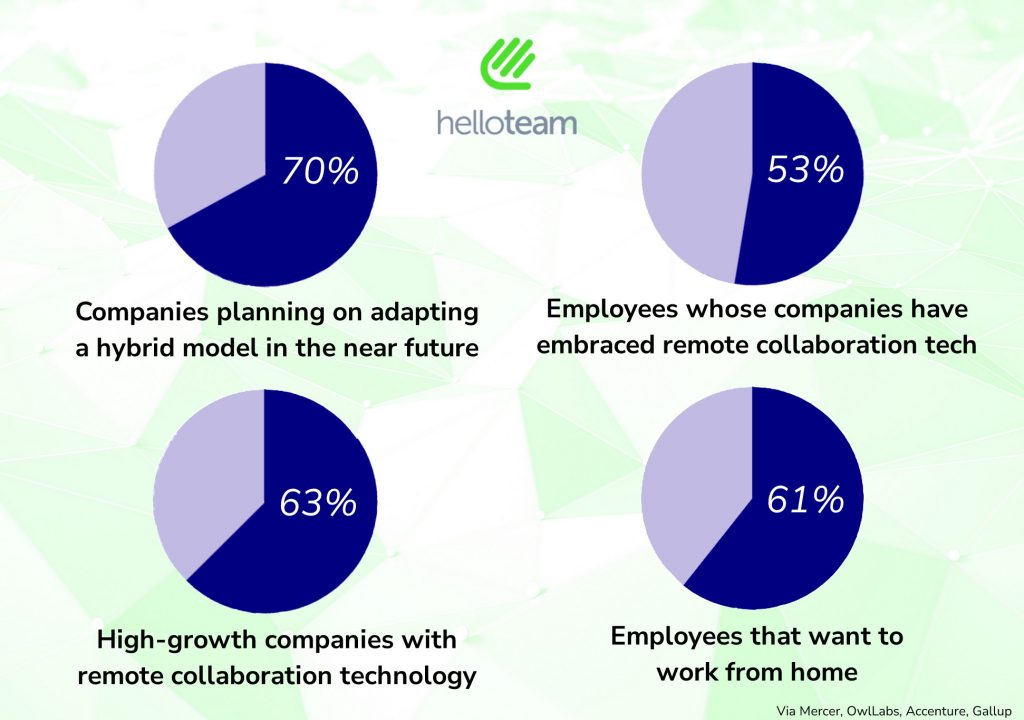Whether they knew it or not, all managers made a critical decision with their HR departments in mid-2020. Do we commit to a holistic performance management strategy for our newly remote staff, or do we improvise and take it day-to-day until the COVID pandemic disappears?
Well, hindsight is 20/20 (no pun intended) and the right decision was to settle down and treat the hybrid workplace as the new normal. That’s because it is the new normal – 70% of companies surveyed by Mercer plan on adopting a hybrid model in the near future, and over half of workers from an OwlLabs survey said their companies have already deployed new remote collaboration technology. 63% of high-growth companies in particular have done so, indicating that the trend is speeding forwards instead of backwards.
Hopefully you aren’t leading a workplace that’s been “winging it” for the past 18 months, but it’s true that not everyone planned ahead. If you are, don’t worry, it’s not too late to roll out a performance management plan for your hybrid workforce. In case you aren’t sure if your team wants to commit to a hybrid plan, you could send out a survey – but a lot of companies have done that for you.
Gallup found that 61% of U.S. employees want to work from home, which means that you’re instantly catering to most of your staff by mastering remote management.

For those that have been struggling without a performance management plan for the last 18 months, that does beg the question: What does a good performance management plan for hybrid workers look like?
There are countless different strategies and methods that work from team to team, but here are five of the most reliable —
- Frequent and reliable communication
When you and your employees are miles apart, communication is the one and the only thing you have to lean on. You can’t afford to pay any less than your utmost attention to the method you communicate through and its effectiveness.
Misunderstandings are a lot more frequent when messages are scarce and tasks aren’t clear enough. Whether you choose to master the art of messaging, sort out group chats, or embrace video conference calls, communication needs to be consistent and focused.
There’s more to communication than handing out assignments, though — you should always get to know your team and their morale a little more personally, especially newer team members. It’s impossible to put your finger on the pulse of how your remote team is feeling without discussing it directly. For that, we need one-on-one meetings.
- The Art of the One-on-One
Video calling with your team members face to face is essentially a recreation of the in-person work experience, which is why it’s so vital. As much as most people like to champion working remotely, it’s very difficult to align with your company or employees without speaking in a one-on-one meeting.
The key is to differentiate the discussions you have face to face from the ones you have over text/email. Through messaging, it’s simple to ask about progress made on assignments and future goals. While you use messaging for short updates, use one-on-ones for discussions that are (slightly) more personal.
Ask them about their workload and any stress it brings, their connection to the company culture, and other important parts of working life that are difficult to get a feel for without spending time in person with them. Project updates and more concrete discussions are important too, but don’t abandon the more human aspect of work.
- Clear Goal Setting
As we touched on earlier, misunderstandings can play a big role in the lives of remote workers. They shouldn’t. While you can certainly concentrate on being very particular in your instructions to each person, there’s a cleaner and more effective way to set goals and align your team: OKRs.
OKRs (Objectives Key Results) are a method of goal setting that involve setting three or more smaller objectives in service of a large, big picture goal. When you assign an employee a task that works towards a small objective that in turn works towards a large goal, everything becomes easier to envision. Alignment is the name of the game, and creating OKRs to share with your team does just that.
You don’t necessarily have to choose OKRs (SMART goals are another favorite) but as long as each person’s assignments work towards a bigger picture and the purpose of their work becomes evident, misunderstandings will fade away.
P.S. Oh, and of course, don’t be vague.

- Recognize and Reward Your Team
Employee recognition is one of the most often-overlooked issues with hybrid work. Those who work on-site get live feedback from their bosses when they do a good job. It can be as simple as grabbing something from the printer or as grand as completing a quarter-long project, but it always feels better to see a smile and hear a thank you from a superior.
For those who work from home, that positive reinforcement is harder to come by. It can feel like whatever they write or complete is sent out into the ether, never to be seen again. On to the next task.
Live feedback is critical to making sure your team members feel satisfied with their jobs and appreciated by the company. Genuine compliments on their work go a long way to motivate — and to curb turnover. If you want to take it a step further, rewards programs like Divvy prompt teams to work to earn prizes like gift cards for a job well done.
Boost employee morale, motivation, trust and performance while making goal completion more dynamic.
- Learning Management Systems
Through no fault of their own, deskless workers can find themselves lagging behind those who work in person in terms of how much they’re learning as they go. It’s not just a matter of experience, but it’s a matter of training and updating industry standards.
Learning Management Systems can fix that. They’re online training courses that both onboard new employees quickly and keep current employees knowledgeable about best practices. You can tailor the courses to your workplace’s needs and track everyone’s progress online to ensure they’re up to date.
In no time, everyone on your team from the home to the office will be fully trained and on the same page. Never underestimate a good education!
In the end, performance management isn’t just about performance — it’s about engagement. Bringing these two together is a remedy for dissatisfaction and turnover, especially in the case of hybrid workplaces. Keep your team engaged as well as productive, and it’ll almost feel like everyone’s at the workplace with you. Good luck!